IoT application technology development - LoRa
LoRa technology has the characteristics of long distance, low power consumption (long battery life), multiple nodes, and low cost.
At present, LoRa mainly operates in free frequency bands around the world, including 433, 868, 915 MHz, etc.
The LoRa network is mainly composed of terminals (with built-in LoRa modules), gateways (or base stations), network servers and application servers. Application data can be transferred in both directions.
The LoRaWAN network architecture is a typical star topology. In this network architecture, the LoRa gateway is a transparent transmission relay that connects the terminal device and the back-end central server. End devices communicate with one or more gateways using a single hop. All nodes and gateways are two-way communication.
LoRa terminal equipment
The terminal nodes of LoRa may be various devices, such as water and gas meters, smoke alarms, pet trackers, etc. These nodes are first connected to the LoRa gateway through LoRa wireless communication, and then connected to the network server through the 3G network or the Ethernet network. Communication between the gateway and the network server is through the TCP/IP protocol.
The LoRa network divides terminal devices into three categories: A/B/C:
Class A: Two-way communication terminal equipment. This type of terminal equipment allows two-way communication, and each terminal equipment upstream transmission will be accompanied by two downstream receive windows. The transmission time slot of the terminal equipment is based on its own communication requirements, and its fine-tuning is based on the ALOHA protocol.

The power consumption of Class A equipment is the lowest, and the downlink communication of the base station can only be performed after the terminal uplink communication.
Class B: Two-way communication terminal equipment with preset receive time slots. This type of terminal device will open redundant receiving windows in the preset time. To achieve this, the terminal device will receive a Beacon from the gateway synchronously, and synchronize the time of the base station and the module through the Beacon.

Class B terminals can let the base station know that the terminal is receiving data
Class C: Two-way communication terminal equipment with maximum receive window. End devices of this type keep open the receive window and close it only when transmitting. Class C devices have the longest receive windows and consume the most power
LoRa Alliance
The LoRa Alliance is an open, non-profit organization led by Semtech in March 2015. Its founding members include Actility in France, AUGTEK in China, and Royal Dutch Telecom kpn. In less than a year, the alliance has developed more than 150 member companies, including IBM, Cisco, Orange and other heavyweight manufacturers.
There are a large number of enterprises in each link of the industrial chain (terminal hardware manufacturers, chip manufacturers, module gateway manufacturers, software manufacturers, system integrators, network operators), the openness of this technology, competition and cooperation. Adequacy has promoted the rapid development and ecological prosperity of LoRa.

LoRaWAN Protocol
LoRaWAN is a Low Power Wide Area Network (LPWAN) standard based on the open source MAC layer protocol launched by the LoRa Alliance. This technology can provide a local, national or global network for battery-operated wireless devices. LoRaWAN targets some of the core needs in the Internet of Things, such as services such as secure two-way communication, mobile communication, and static location recognition. This technology enables seamless interconnection and interoperability between smart devices without the need for complex local configuration, giving users, developers and enterprises in the IoT field free operation rights.
LoRa vs NB-IoT
We have introduced NB-IoT in previous articles. At the same time, as the wireless communication technology of the Internet of Things, NB-IoT and LoRa have different technical and commercial characteristics, so there will be different application scenarios.
At present, from the perspective of industry development, a complete industrial chain has been formed consisting of seven major links: chips, modules, terminals, communication equipment, platforms, operators and applications. Compare NB-IoT and LoRa:

Frequency bands, quality of service and cost
LoRa works in the unlicensed frequency band below 1GHz, so there is no additional charge for application. NB-IoT and cellular communications use licensed frequency bands below 1GHz. The frequency band between 500MHz and 1GHz is the optimal choice for long-distance communication, because the actual size and efficiency of the antenna are quite advantageous.
LoRaWAN uses free unlicensed frequency bands and is an asynchronous communication protocol, which is the best choice for battery power and low cost. LoRa and LoRaWAN protocols have unique characteristics in handling interference, network overlap, scalability, etc., but do not provide the same quality of service (QoS) as cellular protocols.
It is reported that the auction of the authorized Sub-GHz frequency band is more than 500 million US dollars per MHz. Cellular networks and NB-IoT do not offer the same battery life as LoRa due to quality of service (QoS). Due to QoS and high frequency band usage fees, cellular networks and NB-IoT are recommended for application scenarios that need to ensure QoS. LoRa is a good choice if low cost and a large number of connections are preferred, as shown in the figure below.
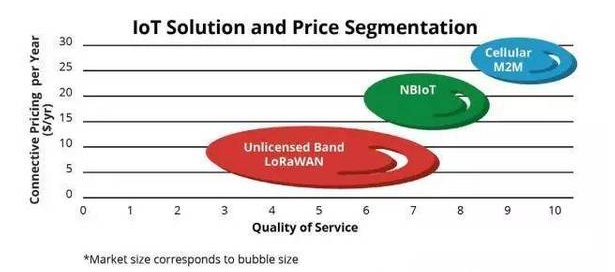
Battery Life and Downlink Latency
The idea behind cellular network design is optimal frequency band utilization, with a corresponding sacrifice of node cost and battery life. On the contrary, LoRaWAN nodes are born for low cost and long battery life, and there are certain deficiencies in frequency band utilization.
There are two important factors to consider in terms of battery life, the current consumption of the node (peak and average current) and the protocol content. LoRaWAN is an asynchronous ALOHA-based protocol, which means that nodes can sleep long or short according to the needs of specific application scenarios, while nodes of synchronous protocols such as cellular must be regularly networked.
For example, mobile phones on the market now have to synchronize with the network every 1.5s when working. In NB-IoT, this synchronization becomes less frequent but still occurs regularly, which consumes additional battery power.
Modulation in cellular networks is an efficient means of making the most of the frequency band, but it is not efficient from a node perspective. Cellular modulation (OFDM or FDMA) requires a linear transmitter to generate the modulated signal, and a linear transmitter requires orders of magnitude more peak current than nonlinear modulation, and higher peak currents consume more power from the battery .
But the synchronous communication protocol has the advantage in terms of shorter downlink delay, while NB-IoT can provide fast data transfer rate for applications that require large data throughput. And Class B of LoRaWAN shortens the delay of downlink communication by periodically (programmed) waking up the terminal to receive downlink messages.
Therefore, NB-IoT may be a better choice for applications that require frequent communication, short delay or large data volume, and for scenarios that require lower cost, higher battery life and infrequent communication Say LoRa is better.

Equipment Costs, Network Costs and Hybrid Models
For end nodes, the LoRaWAN protocol is simpler and easier to develop than NB-IoT, and is more suitable and compatible with microprocessors. The modulation mechanism and protocol of NB-IoT are more complex, which requires more complex circuits and more costs. At the same time, NB-IoT is taxed like 3GPP.
At this stage, the tax for a mobile phone is about $5, but this is too expensive for IoT devices, and if the tax is rashly reduced, it will cause price confusion in the mobile communication market such as mobile phones. Therefore, how the 3GPP organization weighs the tax issues of IoT and mobile communication is also a big problem.
Low-cost, relatively mature LoRa modules are already available in the market, and upgrades will follow. The LoRa Alliance does not have too many restrictions on copyrights and taxes, making the module less than $4 in the LoRa industry chain very impressive. The price of LoRa modules on the market today is generally 7-10 US dollars, but as the technology matures, 4-5 US dollars is not a big problem. And now an LTE module is hard to come by for less than $20.
Compared with the traditional "iron tower" network, the deployment of IoT and LPWAN requires the use of different models to reduce expenditure and operating costs. LoRaWAN deployment is less expensive as it can be done using traditional cell towers, industrial base stations or even portable home gateways.
At this stage, the price of a tower base station is about US$1,000, the price of an industrial base station is less than US$500, and the price of a home gateway is only about US$100. But for NB-IoT, the price of upgrading existing 4G LTE base stations is conservatively estimated to be no less than $15,000 each.
Application scenarios of LoRa and NB-IoT
No single technology can meet all the needs of IoT applications at the same time. The following will analyze the suitable application scenarios of NB-IoT and LoRa through several specific application examples.
A: Smart meter
Companies and departments involved in the field of smart meters require high-speed data transmission, frequent communication, and low latency. Since the meter is powered by the mains, there is no need for ultra-low power consumption and long battery life. And it is also necessary to conduct real-time monitoring of the line network so as to deal with hidden dangers in time.
ClassC of LoRaWAN can achieve low latency, but NB-IoT is a more suitable choice for smart meters for high transmission rates and frequent communication requirements. And electricity meters are generally installed in fixed locations in densely populated areas, so it is also easier for operators to deploy their networks.
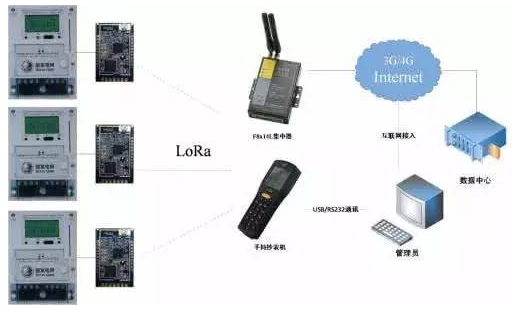
B: Smart Agriculture
For agriculture, low-power and low-cost sensors are urgently needed. The application of temperature and humidity, carbon dioxide, salinity and other sensors is of great significance for agriculture to increase production and reduce water consumption. These sensors need to upload data regularly.
LoRa is very suitable for such scenarios. And many remote farms or arable land are not covered by cellular networks, let alone 4G/LTE, so NB-IoT is not as suitable for smart agriculture as LoRa.

C: automated manufacturing
The operation of factory machines requires real-time monitoring, which can not only ensure production efficiency but also improve labor efficiency through remote monitoring. In automated manufacturing and production in factories, there are many different types of sensors and devices.
Some scenarios require frequent communication and ensure good quality of service (QoS), then NB-IoT is a more suitable choice. In some scenarios, low-cost sensors with low-power and long-life batteries are required to track devices and monitor status. At this time, LoRa is a reasonable choice. So for the diversity of automated manufacturing, both NB-IoT and LoRa are useful.

D: Smart buildings
For the renovation of the building, sensors such as temperature and humidity, safety, harmful gas, water flow monitoring are added and the monitoring information is regularly uploaded, which is convenient for managers to supervise and more convenient for users.
Generally speaking, the communication of these sensors does not need to be particularly frequent or guarantee a particularly good quality of service, and portable home gateways can meet the needs. So LoRa is a more suitable choice for this scene.
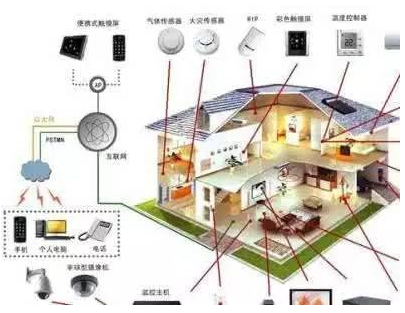
E: Point of Sale (POS)
Point-of-Sale (POS) systems tend to require more frequent and high-quality communications, and these devices usually have dedicated power supplies, so there is no requirement for longer battery life. At the same time, the timeliness and low latency of communication are required to be high. Therefore, NB-IoT is more suitable for this application due to the above considerations.
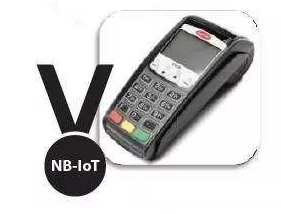
F: Logistics tracking
An important requirement in the tracking or positioning market is the battery life of the terminal. Logistics tracking can be a practical example of a hybrid deployment. The logistics enterprise can deploy the network in the required place according to the needs of positioning, which can be in the warehouse or on the transportation vehicle. At this time, the portable base station will come in handy.
LoRa can provide such a deployment solution, but for NB-IoT, the laying of base stations with too large tracking range is a big problem. At the same time, LoRa has a feature that the communication is more stable than NB-IoT when moving at high speed. For the above considerations, LoRa is more suitable for logistics tracking.
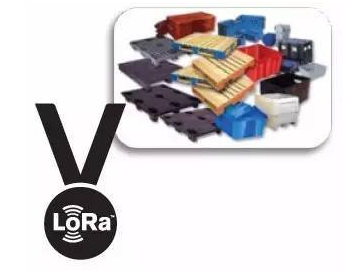
A technology from paper to commercial is inseparable from the support of a strong ecosystem. For a long time, IoT connection technologies have been fighting against each other, and the specifications adopted by all parties from the chip to the system are different, causing a bottleneck in large-scale deployment.
Today, the successive deployment of operators such as China Telecom, China Mobile, China Unicom, Huawei and Qualcomm has gradually built an ecosystem supporting the NB-IOT technology industry. It has also made the ecology of the LoRa technology industry preliminarily formed.
Both technologies continue to expand, and the conditions for them to embrace the Internet of Everything are slowly beginning to mature. A large number of suppliers and operators are also continuously launching pilot projects. It is believed that the complementary development of NB-IoT and LoRa will greatly promote the innovation and progress of IoT technology in the future.